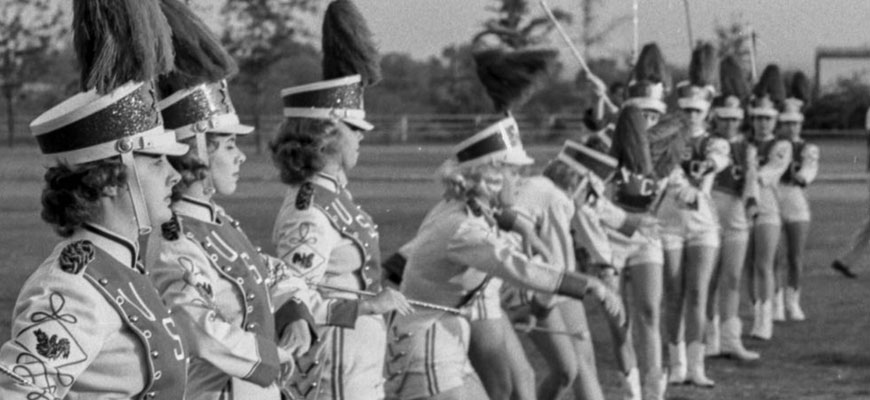
The Mighty Sound of the Southeast turns 100
Tribute to University Marching Band planned Sept. 25 to mark milestone
Posted on: September 15, 2020; Updated on: September 15, 2020
By Chris Horn, chorn@sc.edu
Start with 20 piccolo players, add three dozen clarinetists and an equal number of saxophones. Then stir in 60 trumpeters, 35 trombones, 30 sousaphones and 30 drummers. Sounds like a marching band, right?
That’s enough musicians to sound like a marching band, but if we’re talking about the Mighty Sound of the Southeast, the University of South Carolina’s Marching Band, it’s got to look the part, too. So add a 20-member dance team, the Coquettes, a 24-member flag-waving color guard and two or three feature twirlers who can toss a baton sky high and snatch it every time. Now you’ve got a real marching band.
The university’s Marching Band might have had humble origins — fewer than 20 members when it began a century ago in 1920 — but it’s now considered one of the best in the country. And even though its centennial anniversary lands in the midst of a pandemic, a virtual tribute to the Mighty Sound of the Southeast takes place Friday, Sept. 25. Tune in to facebook.com/uofsc at 7 p.m. the day of the show.
Many bands across the country have their roots in military marching bands that go all the way back to the fife and drum units that were used to direct battle.
Cormac Cannon, director of university bands
As you might imagine, the band has marched to the beat of different drummers over the past 100 years. Like most of its counterparts at other institutions, the University of South Carolina Marching Band started out playing traditional military marching tunes of its day — tunes such as John Philip Sousa’s “Stars and Stripes Forever” and Joseph Franz Wagner’s “Under the Double Eagle.”
“Many bands across the country have their roots in military marching bands that go all the way back to the fife and drum units that were used to direct battle,” says Cormac Cannon, director of bands in the School of Music. “The early marching bands at colleges were playing marches, and doing the military formations and crisp turns that you would associate with that style.
“When our legendary director Mr. Copenhaver came here in the mid ’70s, marching bands had really become more like show bands, performing popular music and doing movements that broke from military tradition — making different shapes and pictures on the field with effects like flash cubes and smoke from fire extinguishers.”
Students directed the Marching Band its first few years. In 1923, George Olson, the dean of the School of Commerce, precursor to today’s Moore School of Business, was appointed band director and served in that capacity for 23 years.
During the World War II years, the band began wearing garnet-and-black uniforms and band membership hit about 50. With many of its members joining the armed services, the band admitted its first females, though limiting them at first to serving only as majorettes.
There are a lot of connections that just last a lifetime through the band.
Jennifer Jablonski, '93, former band member, assistant dean for enrollment management in the School of Music
By the 1950s, the band began performing bigger pre-game and halftime shows, setting the stage for major expansion in the 1960s and ’70s when band director James Pritchard acquired a recording studio and more storage and practice areas. Pritchard also created the Coquettes, the marching band’s dance team. He also worked with Paul Dietzel, the athletics director and football coach from 1966 to 1974, who penned words to what would become the university’s new fight song, “The Fighting Gamecocks Lead the Way.” The band membership reached 350 during this era.
James Copenhaver, who would direct the marching band for 21 years, took the reins in 1976 and began the tradition of recruiting champion twirlers to the ensemble. In 1981, the band began playing what would become its signature “2001” theme song, though crowd noise overwhelmed the music in its debut. Two years later with the addition of a new sound system, the dramatic introduction was heard loud and clear and became a fan favorite. When the university joined the high-profile Southeastern Conference in 1991, then-band public information director Brian Murrell, ’84, suggested the band’s nickname “The Mighty Sound of the Southeast.”
Jennifer Jablonski, assistant dean for enrollment in the School of Music, played in the marching band as an undergraduate in the early ‘90s and has fond memories of performing and not-so-fond memories of insect bites when chiggers invaded the band practice field one year. What lasts, she says, are the friendships.
“There are a lot of connections that just last a lifetime through the band,” Jablonski says. “I mean, it is amazing how powerful the network is and to think how often I continue to see those people and spend time with them and choose to include them in my life and they choose to include me in theirs. That's just something that's very special you can't get any other way.”
Learn more
Want to know more about the Mighty Sound of the Southeast? Visit 100.carolinaband.org to see vintage photos and inside stories about the band’s 100-year history. Also listen to our latest Remembering the Days podcast on "100 Years of the Mighty Sound."
Share this Story! Let friends in your social network know what you are reading about